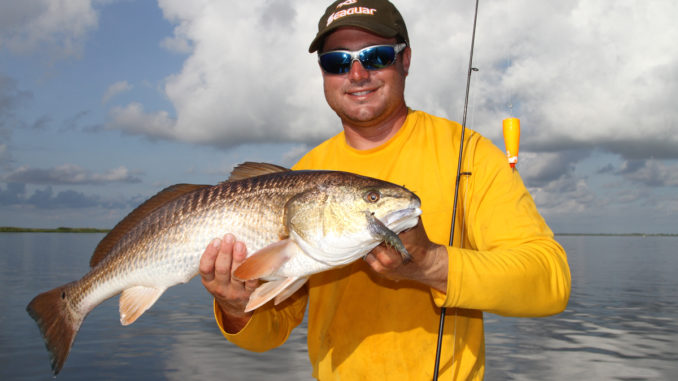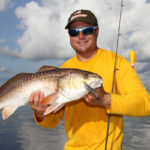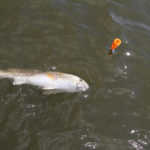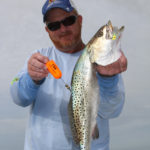
Popping-cork rigs are effective at attracting trout and reds to suspended baits and lures
Call it trick-or-treat fishing. No Halloween connection here, but popping cork rigs are definitely designed to trick fish into finding a treat — one that’s actually more of a trick itself.
In it’s simplest form, this technique employs a cone-shaped float with a broader, concave top, typically with a removable plastic pin to cinch your line against the inner core. Placed a few feet above an artificial or natural bait, the cork creates a gurgling commotion when pulled with a sharp rod snap.
Predators mistaking it for the sounds of surface feeding rush to the scene to claim their share of the bounty. What they find, instead, is a vulnerable offering suspended beneath.
The past couple of decades have seen the basic popping cork take a backseat to the clacking cork rig, comprising a wire stem with a sliding float flanked by noisy beads and swivels at each end. With main line tied to the top swivel and leader to the bottom one, this rig cranks up the noise with more moving parts.
In any form, the popping-cork technique is a user-friendly option that even beginners can fish with reasonable success. Attention to technique matters, so we asked a couple of float-fishing aficionados for pointers.
Keep ’em in suspense. Favoring the deep impact of a weighted Cajun Thunder cork rig with an oval float, guide Tom Siwarski of Charleson’s Carolina Aero Marine Adventures tempts his fish with a 1/4-ounce D.O.A. shrimp. He likes the glow color in stained water and clear for higher visibility.
“I’ll switch back and forth; I also throw a lot of shrimp,” he said. “But I find that the more the water warms us, live shrimp becomes harder to fish because of all the (trash fish). Everything from about 2 inches up eats shrimp.
“A live shrimp will always outfish an artificial shrimp head-to-head, but I find I can outfish live shrimp with the D.O.A. because it’s so much more efficient. You’re not dealing with bait stealers; you’re not casting the shrimp off, there’s just so much more fishing time.”
Offering a different view is guide Rob Bennett of Lowcountry Fishing Charters, who makes his living in the marshes and creeks around Kiawah, Seabrook and Edisto islands south of Charleston. Before shrimp move into the rivers, he’ll occasionally throw an artificial version; but when the fish are targeting natural forage, he’s a big fan of the real McCoy. He knows the limitations but feels the authentic appeal offsets any such concerns.
“I fish both, but I’m really a live-shrimp advocate; it’s just what I grew up with,” Bennett said. “It’s the smell. Even though you can’t smell it, a fish can.”
Keeping shrimp alive is paramount, so Bennet hooks his just barely under the horn with a 1/0-3/0 Kahle hook. He prefers bronze hooks because he’s found them to be the sharpest.
In addition to shrimp, other live bait options include lip-hooked mud minnows, small menhaden and finger mullet.
Rigging particulars. Bennett said he’s tried a variety of cork rigs, but he consistently finds the ones packing cone-shape floats with concave tops offer less wind resistance on the cast and produce the best trout-calling sound on the water. On the rig’s bottom end, he ties a 20- to 30-pound fluorocarbon leader to which he’ll add a small split shot about 6 to 8 inches above the bait.
“That adds just enough tug to keep my shrimp down in the zone,” Bennett said.
Corks rigs come in a range of colors, with neon green, orange and yellow the common options. Siwarski has found little evidence of fish preference, but he does value color variance for logistical benefits.
“As a charter captain, I try to alternate cork colors with my anglers so if I see a cork go down, I can just say ‘Green cork,’ or ‘Yellow cork,’ instead of trying to figure out whose cork it was,” Siwarski said. “It’s a lot more efficient.”
Top targets. Siwarski breaks own his corking presentations by two main tidal preferences. Working an incoming tide, he fishes long grass lines and targets certain pockets, particularly those with shell bottoms. He said the last two hours of rising water provide a good mix of trout, which prefer the perimeters, and redfish, which nose right up to the vegetation to hunt crabs and various invertebrates.
“I like to be in 3 to 6 feet of water, but I will fish as deep as 10 feet,” Siwarski said. “A fish will come up all-day long to hit a shrimp that’s 4 feet under cork.”
When the tide turns, he uses the first two hours of the outgoing to target creek mouths where redfish capitalize on easy meals. Here, as with the first presentation, the popping-cork rig serves as much as a positioning aid, as a fish attractor.
As Siwarski points out, redfish set up on the corners of creek mouths and ambush all the bait that exits with the falling water. Keeping his bait higher in the water column, the cork directs attention to this meal like a carnival hawker’s shouts of “Step right up!”
Productive presentations. If the popping cork rig has a drawback, it’s the physical dynamics of double pivot points — the point where your main line meets the cork or rig, and then the bait dangling below the float. Unlike tossing a single lure or hooked natural bait, the popping cork deal can be, well, pretty unwieldy.
Siwarski overcomes this consideration with patient, measured casting.
“With a lure, most people will whip it back and whip it forward; but with the popping-cork rig, I tell my people to bring it back behind them and make a conscious pause before you make a forward motion,” Siwarski said. “I tell them to look behind them to make sure it’s all clear and just let (the cork rig) hang straight vertical.
“Then, you come forward in a fluid motion compared to a quick snap like you would with a grub or something else.”
Given the objective of attracting fish by simulating aggressive feeding, Siwarski said you can’t snap a popping cork too hard. You can, however, snap one too frequently and cover too much water. Siwarski generally allows five to 10 seconds between snaps — one deep snap or two short snaps — and adjusts as needed.
“I generally start off snapping it at a faster frequency, and if I’m not getting bit, I’ll slow it down,” he said. “I’ll tell people to count to themselves, because you think five seconds goes by fast, but when you count one-thousand-one, one-thousand-two, one-thousand-three; it’s longer than it seems.”
Beyond the cadence, Siwarski explained the his bait choice determines how he’ll progress his rig. Think about it: A chunk of rubber and metal can withstand a whole lot more force than a delicate crustacean.
“With the shrimp, the key is that you want that cork not to move much,” he said. “You want minimal movement with maximum splash. Leaving a little bit of slack in the line will help prevent you from dragging the bait too far.
“Get that cork to sit in the same spot as long as you can, instead of dragging it 4 feet every time you pop it. If you drag a live shrimp too far, you’ll kill it or pull it off the hook. You just want that bait to jump a little bit.”
Conversely, Siwarski treats a D.O.A. shrimp far more harshly, because it can take it.
“I’d drag that cork farther with an artificial shrimp because you want that bait to come up in the water column,” he said. “That will give it time to fall naturally. So, with live bait, you want to draw the fish to the area where they’ll see the live bait sitting there; but with an artificial bait, you want to drag that cork 3 or 4 feet so the fish will hear that noise and then come over and see that shrimp falling.”
Siwarski also varies his strike response with bait type. Fish tend to chomp on the real thing longer, so he gives a 2-count before setting the hook. On the other hand, a trout or redfish that eats an artificial quickly realizes its mistake, so as soon as that cork goes down, hit ’em hard.






Be the first to comment